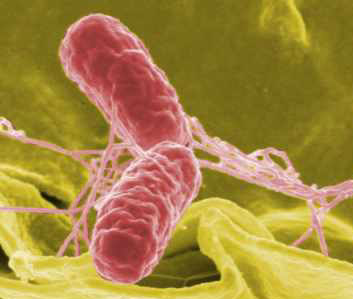Salmonella bacteria can be modified to make a safe anti-cancer treatment, scientists have shown.
 Salmonella is known to be effective at killing tumours. Until now though, owing to the risk of killing patients from Salmonella poisoning, it hasn't been possible to use it therapeutically in this way.
Salmonella is known to be effective at killing tumours. Until now though, owing to the risk of killing patients from Salmonella poisoning, it hasn't been possible to use it therapeutically in this way.
Modifying the bacterium to make it less harmful, unfortunately abolishes the anti-cancer effect.
Now, writing in the journal mBio, Arizona State University scientist Roy Curtiss and his colleagues have discovered a way to genetically engineer the organism to be almost harmless to healthy cells, while remaining lethal to malignant ones.
Salmonella thrives in cancer cells, dividing around 12 times faster than in normal cells.
"The tumour is an exceedingly nutrient-rich environment," explains Curtiss. This is because tumours are quite literally awash with nutrients, which enable the bacteria to thrive.
But why investigate Salmonella? "We wanted to design a microbe by genetic manipulation with only the behaviours we wanted" says Curtiss. "We probably know more about its lifestyle, genetics and mechanisms of causing disease than for any other bacterial pathogen."
The team started by genetically engineering the Salmonella bacteria to prevent them producing a substance on the bacterial surface known as lipopolysaccharide (LPS). When present, this causes profound inflammation and can lead to shock and circulatory collapse.
To make the modified microbe effective at killing cancers, they then made a second genetic alteration that prevented the bacteria producing LPS except in the presence of a sugar called Arabinose-C.
When bacteria grown on an Arabinose-rich medium are injected directly into a tumour, the LPS present in the bacteria triggers an overwhelming immune response that attacks the tumour cells. As the microbes multiply rapidly within the tumour, they rob it of nutrients and destroy it.
Any Salmonellae that escape from the tumour lack the Arabinose required to make LPS. This not only makes them non-toxic to healthy cells but also highly susceptible to being destroyed by the immune system.
The researchers were able to prove the effectiveness of technique in mice. "The tumour shrinks, it essentially disappears from being visible," Curtiss explains.
Although the team do not expect the Salmonella to be capable of eliminating all residual cancer cells, they are hopeful that it could also trigger the immune system to clean up those that survive.
And while this study was carried out in mice, it could one day form the basis of a cancer treatment for humans. The Salmonella the scientists used in their research has been tested in humans already and studies into using this technique in dogs are just commencing.
"The application to humans might not be as far off as some might think," suggests Curtiss.










Comments
Add a comment